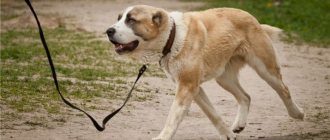Monitoring dog development
If the pet is purchased from a breeder, there is no need to monitor height and weight. To determine when a dog will be considered an adult, it is enough to meet its parents. For professional breeders, this procedure is mandatory even before handing over the puppy. But when the dog is a mongrel from a shelter or from the street, then you need to ask yourself what parameters to expect. It's almost impossible to predict; mongrel crosses are unpredictable.
Post different breeds
To understand to what age puppies grow, regular weighing and measurement of dimensions are required. Up to 2 months this is done on average once every 5 days, from 2 to 6 months - every 10 days, and then once a month is enough.
What to measure:
- standing height at withers;
- paw circumference;
- chest girth;
- height to the elbow.
What should you feed your puppy so that he can fully develop?
Balanced feeding is a factor that directly affects the growth and development of the puppy. Preparing a homemade diet for a growing puppy is quite a complex process, since the body's needs can constantly change depending on the stage of development. The pet grows, its mass increases, which means the ratio of components also changes. A veterinarian nutritionist should prepare and adjust the diet for a puppy.
Industrial food of premium class and higher takes into account the characteristics of the puppy during different periods of growth and satisfies the body's needs, subject to daily feeding standards.
The age at which dogs grow can vary from 8 months to 2 years. The growth of a mongrel depends on genetic data, but they reach approximate size by 8-10 months. The development of any puppy is influenced by many factors, most of which must be taken into account by the owner.
Basic patterns of rocks
Small breed food for puppies as well as large and medium breeds
Each species has a different period of full maturity. Below is a look at when dogs stop growing in the most common breeds:
- the German shepherd, like the husky, actively develops up to one year, and until two years of age it develops until it reaches full maturity;
- in a Rottweiler, growth ends by the age of one year, the muscles are finally formed at 2.5 years;
- the Yorkshire Terrier becomes fully mature at eight months;
- the dachshund develops up to 8 months and then grows only in width;
- Pugs grow from 5 to 9 months;
- in the Pekingese, maturation depends on gender: the male develops up to a year, the female develops faster, up to 8 months;
- The toy terrier is the fastest developing dog; full maturity is completed by 5 months.
For your information! In nature, there is such a variety of dogs as mestizo, which is neither a purebred nor a mongrel. No one can predict the growth of these individuals.
What does a mestizo look like?
How should you monitor your puppy's development?
The development and growth of each puppy is individual, since all processes in the body occur differently. You need to pay special attention to your pet's changes during the first year of life. It is at this time that physiological and anatomical features are laid down and established. Growth and development are two concepts that are interconnected in a puppy’s life.
What to pay attention to:
- After birth, all puppies must be fed their mother's milk. If one of the litter lacks nutrition (for example, more active puppies are pushed away), place it near the female’s mammary glands.
- A grown individual. The pet should be active, playful, curious, and moderately emotional.
- At about 2 months of age, puppies begin to change their coat from baby fluff to coarser adult guard hairs.
- Before scheduled vaccination (until the end of the quarantine period), you cannot take your pet outside; contact with other animals is excluded.
- The puppy's gait is confident, light, and his movements are free. Any deviations (lameness, shuffling, incorrect positioning of the paw, etc.) are an important point at which it is worth contacting an orthopedic veterinarian.
- During the period of changing teeth, the condition of the oral cavity is checked once every 4-5 days. The permanent tooth must push out the temporary tooth and grow in its place. An incorrect process of changing teeth leads to the development of a number of pathologies (changes in bite, gastrointestinal disorders, etc.).
- Skin, fur, ears must be clean. The appearance of itching, peeling, and redness are signs of the disease.
- General condition of the pet. Refusal to eat, diarrhea, vomiting, and depression are extremely dangerous conditions for a growing animal in its first year of life. If symptoms appear, you should immediately contact a veterinary clinic.
The age at which a dog stops growing depends on anatomical and genetic data. After all changes are completed, the pet becomes mature. Further changes in the body will be aimed at maintaining vital functions, fighting possible illness, and hormonal changes during various periods of the reproductive cycle in females.
A dog's development lasts throughout its life. This process is influenced by external conditions: maintenance parameters, adaptation situations, seasons, etc.
Prenatal period
To what age do cats grow - regular and purebred?
The period of development inside the womb is divided into several parts. The first stage is completed by the 18th day, development occurs due to food reserves. Next, the liver and kidneys are formed and blood circulation starts.
In the second stage, signs of pregnancy appear in the mother dog. The embryo takes on the shape of a mammal. The nose, eyes, jaws, limbs are formed, the fetus is rapidly increasing. At the end of this period, almost all formation ends, but hair does not appear.
During the last third period, the main growth process takes place: the development of the brain, respiratory tract, bone skeleton, digestion and genital organs.
When does a dog get older?
The period in which an adult dog begins to be older depends not only on the date of his birth, but also on his body weight. Giant dogs (over 50 kg) become elderly already at the age of 5 years, while up to 10 kg only after 3 years, that is, at the age of 8 years.
| Dog body weight | Dog age |
| > 50 kg | 5 years |
| > 30 kg | 6 years |
| > 10 kg | 7 years |
| <10 kg | 8 years |
The table shows at what age dogs become seniors depending on their body weight.
Stages of development and growth
Any animal, before becoming an adult, goes through stages during which noticeable changes occur.
Embryo
How long does pregnancy last in small and large breed dogs?
During this period, the puppy is still in the womb, and there is no contact with the outside world. At this time, the main thing is to take care of the mother and her condition.
Note! The kind of food the dog is given determines what kind of baby the baby will be born and its future health.
suckling baby
After birth, it is very important that the puppy is breastfed. It lasts, depending on the breed, from a couple of weeks to 1.5 months.
Puppy
During this period, breeders give the dogs to their new owners; they are already weaned. This stage lasts from 1 to 6 months. The puppy is actively growing, his teeth are changing. At this time, you need to monitor his nutrition and health (it is important to get vaccinated and treat for possible parasites).
Young animals
From six months to one year, the dog enters adolescence. The puppy is very playful and stubborn at this time. Right now he needs to be educated or given to professionals for training.
Juvenile
By the age of 1 year, almost all dogs have gone through puberty. In appearance, they are no different from an adult, but if it is a large breed, then final maturation will occur by 2 years. It is for this reason that crossing is allowed no earlier than 2 years after birth.
Note! Little puppies that are often sad and lonely develop less well than their happy counterparts.
The first months are considered the most stressful for the animal, so it is necessary to devote maximum time and be patient.
Period from birth to six months
During this period, growth is especially active, and in all breeds, even the smallest. Babies grow upward, their tubular bone structure changes, and their teeth change.
They grow two or three times, and add mass in the same ratio.
At this time, you need to often stroke the puppy, hug him, talk to him, do not punish him just like that, but, if possible, completely replace punishments as such with gestures showing that something is wrong. The baby is distracted, attracted attention with a loud sound, ignored, but not shouted or hit, even lightly. Relationships are built only on such a foundation, and the time for harsh methods will come only in adolescence, with its attempts to take control away from the owner.
A puppy that grows well - eats well, walks a lot, learns new things, does not get sick and is happy because the owner is attentive to him.
How old do dogs of different breeds grow?
The main difference between the maturation of different breeds is that a small breed matures faster, and a large breed takes longer. But you need to at least approximately know how many months dogs grow and the characteristics of each breed in order to track the development of the pet.
Important! In addition to differences in development between breeds, dogs of the same breed but with different sex characteristics also develop differently.
Small breeds
How small dog breeds develop:
- The toy terrier stops growing at the age of 4 months and becomes the size it will be throughout its life;
- the Yorkshire terrier, or Yorkie, grows up to 5 months, then only gains muscle mass;
- Pugs grow from 5 to 9 months;
- Dachshunds grow in length up to 8 months and then only in width.
Small breeds develop faster
Medium dogs
Medium-sized dogs develop and mature at the same rate - from 10 months to 1 year. Some then only gain muscle mass.
Large individuals
The fastest growing large dog breed is the German Shepherd, which grows within a year. But the Irish Wolfhound grows up to 2 years, but after that it still gains muscle mass.
Peculiarities of puppies growing up
Each puppy, regardless of breed, grows up according to several similar principles. There are two main periods, which are accompanied by their own developmental characteristics - before six months and after.
Puppies up to six months
Newborn puppies grow the most actively, since by six months they need to increase in weight three times (compared to their parameters at birth), and also double in height. Up to six months, puppies grow exclusively in height (if they are not overfed).
It is important for puppies up to six months to have foods in their diet that help strengthen bones.
The main danger that awaits the puppy at this stage is incorrectly formed tubular bones. This type of bone continues to grow for several months after the puppy is born, so it is important for the owner to ensure that they develop properly. You can help your animal’s body with a balanced diet that contains the following microelements:
- calcium;
- phosphorus;
- magnesium.
One of the main sources of calcium for a puppy is fermented milk products.
In some cases, veterinarians may prescribe vitamin supplements containing the above elements. However, it is not recommended to give your puppy any supplements without appropriate indications.
Puppies older than six months
Six months after birth, the puppies' chest bone begins to enlarge due to the active growth of flat bones, as a result of which the pet becomes visually wider. Such changes occur at a rapid pace until the age of one, and then slow down significantly.
After six months, external changes in the appearance of puppies become less noticeable
However, despite all the invisibility of subsequent development, the animal will need at least three years for all its bones to be fully formed. As already mentioned, this is important to take into account for those owners who want their pets to take part in mating.
End of growth in different breeds
Each breed completes growth and development differently, it all depends on growth, characteristics, habitat, nutrition:
- a yard dog, or as it is jokingly called a yard terrier. Due to the mixing of breeds, it is difficult to determine when such a dog will finish growing and what size it will reach. How long it will grow can be determined by external signs: if a large breed predominates, then the pet will grow large. Another factor is the size of the baby’s paws: the more massive the baby’s paws are, the larger he will grow and vice versa. If the mongrel is large, then it will grow up to 12 months, small - up to 8 months;
- the German Shepherd stops growing at 1 year;
- the Yorkshire Terrier can grow in 6 months and then only gains muscle mass;
- Pomeranian Spitz grows up to 6 months, after which bones become stronger;
- Great Dane grows up to 1.5 years and then gains weight up to 3 years;
- The mini toy terrier grows faster than all other breeds; by 4 months it becomes fully mature;
- The Chihuahua grows up to 8 months, then the skeleton only gets stronger;
- in a Labrador, growth ends at 1.5 years; at 2.5 years, the bones and muscles are finally formed;
- the husky completes development by 10 months;
- a boxer will mature by 1 year;
- the spaniel grows until about 8 months, then we gain muscle mass until 1.5 years;
- Beagles stop growing at 8 months.
Growth of puppies over 6 months
At this age, the development of small dogs begins to slow down. In a toy terrier it stops completely, in a dachshund it freezes by eight months.
Large dogs expand in the chest and also increase in height - not only the structure of their tubular bones changes, but also the structure of their flat bones. This process is completed by about a year and a half, and the rest of the time the animal matures, reaching the weight of an adult.
Here, all the factors influence are no longer so critical, but this does not mean that you should stop feeding the dog, devoting time to it, or selecting adequate loads for it. The exhibition site is still being built, so there’s no point in letting things slide.
After six months, the food is changed to one richer in proteins, and the loads also change - they become more mature and serious. If a teenage puppy behaves disgustingly, it is already possible to apply acceptable punishments to prevent him from burying himself. See how it is acceptable to punish a dog.
But, if the relationship was established correctly in the first six months, this will not be necessary and the authority of the owner will be recognized.
Factors that influence animal performance
Like any creature, development is influenced by care, feeding, attitude, and activity. In order for your pet to grow up cheerful and healthy, you need to devote the same amount of time to him as you would to a small child:
- nutrition. Your puppy should eat plenty of fiber and protein. Vitamins must be added to food. Empty cereals, cheap food and bones are not the best option;
- loads. Training should begin gradually with the simplest tasks, adding and teaching new, more complex ones in stages. For example, the Estonian hound begins to be trained at 1.5 months;
- activity. Dogs need long walks to become familiar with the world around them and other animals. At first, walks should be taken every time after eating food, but over time, 2 times a day will be enough;
- diseases. It is necessary to see a veterinarian because puppies are very susceptible to various diseases.
The relationship between the age of a dog and a person - myth or reality?
Someone came up with and convinced dog breeders that the ratio of the age of a dog to a person is 1: 7. The statement is correct only for large individuals that have reached the age of two. For example, the human age of a Dachshund dog that has reached 10 years of age will be 65 years old, while a large Great Dane will be 80 years old by human standards.
The approximate correspondence between the ages of a dog and a person can be demonstrated using the following example:
- at 6 months the puppy corresponds in development to a 10-year-old child.
- at 12 months of age - to a 15-year-old teenager.
- By the age of three, the dog reaches its prime, the condition is equal to that of a 28-year-old person.
- a certain decline in activity in the animal occurs at 10 years, corresponding to human 56 years.
- It is known that the longest-living dog lived 21 years; the age of the dog by human standards was within 100 years.
Whether or not to believe such statements about the coincidence of the ages of a person and a dog is up to the owner. The main goal of establishing the exact age of a pet is proper care that meets the dog’s needs, ensuring that the necessary procedures are completed to improve the quality of life.










